When the winter ends and warmer spring temperatures arrive, amphibians emerge from hibernation and migrate to breeding sites to lay their eggs.
Most frogs and toads will lay their eggs in the water, but many will lay their eggs on land.
Amphibian eggs laid in the water can be difficult to tell apart unless you have a close eye to watch for differences.
The easiest way to tell the difference between frog eggs and toad eggs is to look at how the eggs are laid. Most frogs lay their eggs in large clusters, while most toads lay their eggs in long jelly-covered strings, which may look like a string of black beads.
That said, it’s important to note that not all toads lay their eggs in long strings.
A few toad species, such as the red-spotted toad (Anaxyrus punctatus) lay their eggs singly.
Some frog species also lay their eggs singly, or in small packets on the surface of the water (more information on that is below).
Where Do Frogs and Toads Lay Their Eggs?
Generally, many frog and toad species prefer to lay their eggs in shallow standing, or slow-moving, temporary, or semi-permanent freshwater bodies that are free of fish and have little to moderate amounts of vegetation.
This could be in woodland ponds, flooded fields, seasonal pools, temporary rain puddles, flooded ditches, lake edges, river backwaters, open marshes, swamps, artificial ponds, and even deep tire tracks or potholes filled with rainwater.
Some frogs, such as the Wood frog (Lithobates sylvaticus) very strongly prefer to breed in “vernal pools“, sometimes called “ephemeral pools.”

Vernal pools are temporal pools of water that form in the spring. They are formed when depressions on the ground are filled with water from melting snow and falling rain.
They are typically small and shallow, and unlike a pond or lake, they have no permanent source of water. This means they dry up in the summer.
Since they are temporal, they do not have fish or many other aquatic predators that could eat the eggs before they hatch.
This makes them ideal breeding sites for frogs, toads, and many other amphibians.
The Differences Between Frog Eggs and Toad Eggs
Many frog and toad species lay eggs in the same pools, and their eggs can be difficult for the untrained eye to tell apart.
1. Appearance
The easiest way to tell Frog eggs and toad eggs apart is by their appearance.
Most frogs lay their gelatinous eggs in large masses, or clusters, and attach them to submerged vegetation or debris, just below the surface of the water – to keep them from floating away. These egg clusters may look somewhat similar to clusters of grapes.
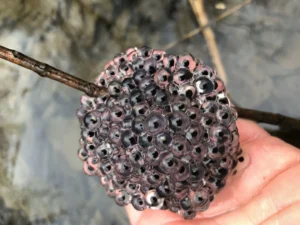

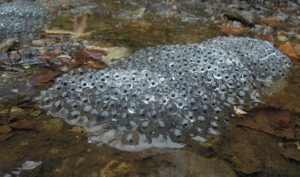
The eggs look like clusters of jelly globs, with a developing embryo visible inside each egg.
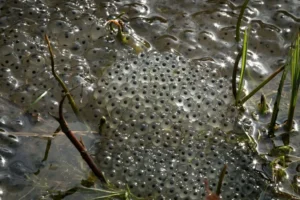
On the other hand, most toads lay their eggs in long gelatinous strands, which may look almost like strings of black beads, or jelly-coated necklaces.



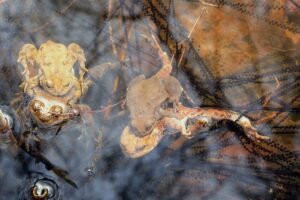
The egg strings wrap around vegetation or lie at the bottom of the water.
No North American frog, European frog, or Australian frog species lay their eggs in strings.
If you live in North America, Europe, or Australia and see amphibian eggs laid in long strings in the water, you can be sure they are toad eggs.
2. Toxins
All true toads toads (of the family Bufonidae) produce toxins as a defense against predators.

These toxins are present not only in Adult toads but at every stage of a toad’s lifecycle. This means the eggs (and tadpoles) of many toad species are poisonous to varying degrees.
On the other hand, the eggs of most frog species do not have any toxins and are not poisonous.
Not All Frogs or Toads Lay Their Eggs the Same Way
Although most frog species lay their eggs in clusters, and most toad species lay their eggs in strings, it is important to note that some frogs, or toads lay their eggs differently.
A few toad species, such as the red-spotted toad (Anaxyrus punctatus) lay their eggs singly. The small eggs may adhere to each other and form small clusters on the pond’s bottom.
Oak toads (Anaxyrus quercicus) lay their eggs singly or in small strands of up to six to eight eggs, either free-floating or attached to vegetation.
Some frog species, such as the Spring peeper (Pseudacris crucifer) lay their eggs singly or in clumps of two or three.
The eggs are attached to submerged vegetation or debris, just below the surface of the water.
Identifying Frog Eggs
A good way to tell frog and toad eggs apart is to learn how to identify the eggs of individual frog and toad species.
Here’s how you can identify the eggs of 6 frog species:
1. Wood Frog (Lithobates sylvaticus)
Wood frog lay their eggs in clusters, attached to twigs or vegetation, just below the surface of the water.
If the pool has lots of emergent vegetation, eggs are often laid in open areas that receive lots of sunlight.
Freshly laid wood frog egg masses are dense and are roughly the size of a golf ball.

Over time, the eggs absorb water and swell to their true size, which is usually roughly the size of a softball.
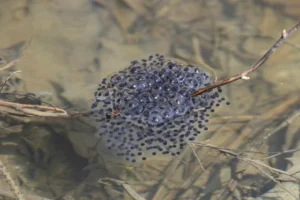
Each Wood frog egg mass can have anywhere from 500, to as many as 2,000 eggs.
A single Wood frog can lay 1,000, to 3,000 eggs in a breeding season.
The embryos in the eggs are black on top and white on the bottom, but as the embryos develop into tadpoles, the white is lost.
Wood frogs often lay their egg masses communally, so it’s common to find large rafts of wood frog egg masses, containing many layers of masses on top of one another.

Over a short time, wood frog egg masses may become colonized by symbiotic algae, giving them a greenish coloration.
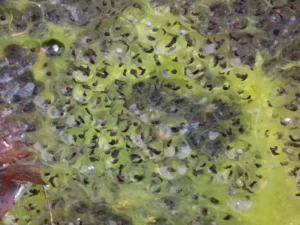
The eggs hatch in 9 to 30 days, depending on the ambient temperatures.
2. Northern Leopard Frog (Lithobates pipiens)
Like wood frogs, Leopard frogs lay their eggs masses are laid in areas of the pool that receive lots of sunlight.
Leopard frog egg masses are typically firm and globular and are about the same size as those of the Wood frog.
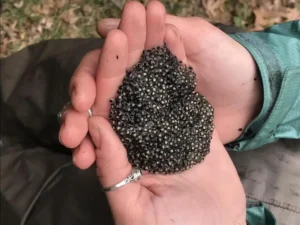
The only difference is that they are much denser (more tightly packed) and contain more eggs – usually 2,000-3,000 eggs per egg mass, but a single egg mass can have up to 6,500 eggs.
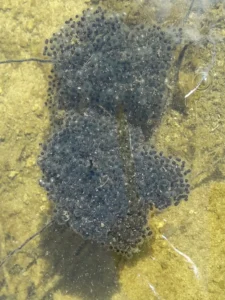
In addition, the layer of clear jelly that surrounds the yolk is much thinner than in wood frog eggs.
Since the egg masses are more tightly packed, the layer of clear jelly that surrounds each embryo is much thinner than in Wood frog eggs.
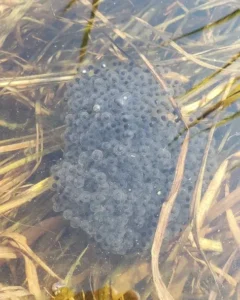
This results in individual Leopard frog eggs being much smaller than those of the Wood frog.
Since Leopard frog eggs have a very thin layer of jelly, they do not appear as clear as Wood frog eggs. Rather, they are black on top and white on the bottom.
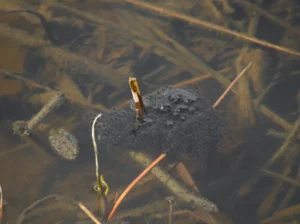
Northern leopard frog eggs take about 7 to 17 days to hatch, depending on the ambient temperatures.
The eggs of Pickerel frogs (Lithobates palustris) are almost identical to those of Leopard frogs. The main difference is that rather than being black on top and white on the bottom, Pickerel frog eggs are brown on the top and a cream-ish yellow on the bottom.
3. Gray Tree Frog (Dryophytes versicolor)
Gray tree frogs lay their eggs in small packets of 10 – 40 eggs on the surface of the water.

A single Gray tree frog can lay 1,000 to as many as 2,000 eggs in a breeding season.
Oftentimes, the egg masses are generally really close to, or loosely attached to debris, branches, or emergent vegetation
Each egg is dark brown on the top and a yellowish cream color on the bottom, and is surrounded by a protective gelatinous mass.

As the embryos develop, Gray tree egg masses will deteriorate and flatten to the point where individual eggs are no longer identifiable from the rest of the floating raft.
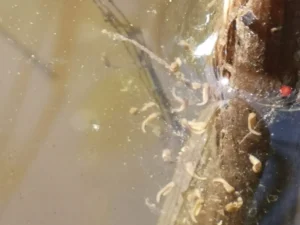
Gray tree frog eggs take about 3 to 7 days to hatch, depending on the ambient temperatures.
4. American Bullfrog (Lithobates catesbeianus)
Unlike most frogs, American bullfrogs do not lay eggs in tight masses. Rather, their eggs are laid in a loose mass draped on underwater plants, slightly below the water’s surface.
After about a day, the egg cluster floats to the water surface and flattens out into a giant thin sheet, only about one or two eggs thick.



Each egg mass can have anywhere from 12,000, to as many as 20,000 eggs.
The eggs take about 3 to 5 days to hatch, depending on the ambient temperatures.
The eggs of the Green frog (Lithobates clamitans) are nearly identical to those of the American bullfrog. The main difference is that American bullfrog egg masses are much larger (over 3ft in diameter) and have 12, 000 to 20, 000 eggs each, while Green frog egg masses are smaller and only have 1,000 to 7,000 eggs.
5. Spring Peeper (Pseudacris crucifer)
Unlike many frogs which lay their eggs in masses, Spring peepers lay their eggs singly or in clumps of two or three.
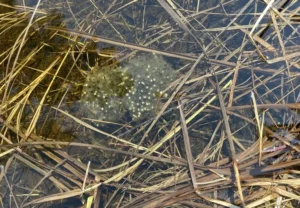
The eggs are attached to submerged vegetation or debris, just below the surface of the water.
A single Spring peeper can lay anywhere from 900 to 1,000 eggs each breeding season.
Spring peeper eggs are very small and can be hard to see when laid singly.

Each egg has a yellowish-cream color and is surrounded by a protective gelatinous mass.

The eggs take about 4 to 15 days to hatch, depending on the ambient temperatures.
6. European Common Frog (Rana temporaria)
European common frogs lay their eggs in clusters, attached to twigs or vegetation, just below the surface of the water.
Each egg mass can have 500, to as many as 2,000 eggs.
Individual eggs are black and have black embryos (that appear as black dots at the center), surrounded by a clear jelly capsule about 1 cm across.

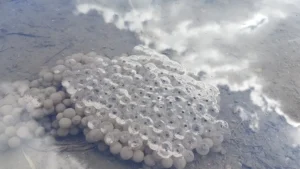
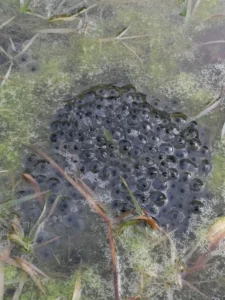

The eggs take about 14 to 28 days to hatch, depending on the ambient temperatures.
Deposit ‘rafts’ of spawn, often containing up to 2000 eggs. Each small black egg is surrounded by a clear jelly capsule around 1 cm across.
Identifying Frog Eggs
Here is how you can identify the eggs of 6 toad species:
1. American Toad (Anaxyrus americanus)
American toads their eggs in jelly-like strings, that attach to vegetation or lie at the bottom of the water.
A single American toad lays between 4,000 and 8,000 eggs, in two long parallel strands.

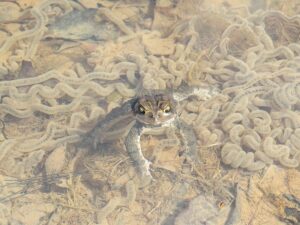

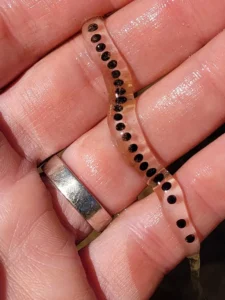
Each egg has a black embryo at the center surrounded by a clear jelly and measures about 1.5 mm in diameter.
Sometimes, the egg strings coil up like an old phone cord.
Over time, sediment may settle on the egg strands, covering individual eggs and making the strands look like giant worms.
2. Fowler’s Toad (Anaxyrus fowleri)
Fowler’s toad eggs look very nearly identical to those of the American toad.
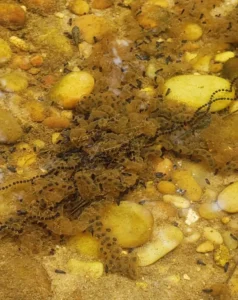
The main distinction between the two is;
- The eggs of the American toad have a double envelope surrounding the eggs, with the individual eggs separated by partitions
- The eggs of the Fowler’s toad have a single membrane, and the individual eggs are not separated by partitions.
Apart from this distinction, the eggs of these two toad species are virtually identical
A single Fowler’s toad can lay anywhere from 2,000 to as many as 10, 0000 eggs in a single breeding season.
The eggs take about 2 to 7 days to hatch, depending on the ambient temperatures.
3. Western Toad (Anaxyrus boreas)
Western toad’s egg strands are usually two eggs wide but are sometimes three eggs wide.
A single egg strand can be up to 60 feet long and contain as many as 7,000 eggs, with the eggs spaced roughly 13 to 52 eggs per inch.
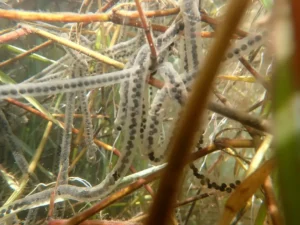
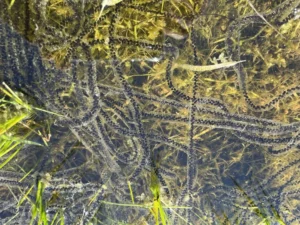
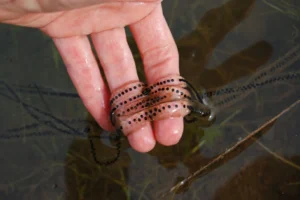
The individual eggs are black on top, and white at the bottom and are surrounded by two layers of jelly.
Each egg is fairly small, only measuring about 1.5 to 1.8 mm in diameter.
The eggs take about 3 to 12 days to hatch, depending on the ambient temperatures.
4. Cane Toad (Rhinella marina)
Like most toads, Cane toads lay their eggs in in long double strands of clear jelly, that wrap around aquatic vegetation.
The embryos appear as black dots in the center of the eggs.
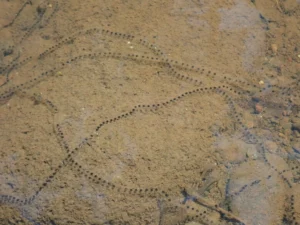

A single Cane toad can lay anywhere from 10,000 to as many as 30,000 eggs in a breeding season and may lay up to 2 clutches per year.
The eggs take about 2 to 3 days to hatch, depending on ambient temperatures.
5. European Common Toad (Bufo bufo)
Like most toads, Common toads lay their eggs in long double strands of jelly.
Each egg strand is very long and may contain as many as 1,500 eggs. The embryos are black and look like dots at the center of each egg.
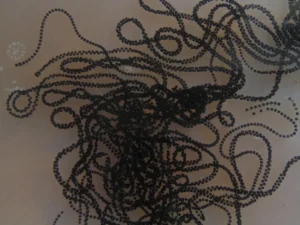
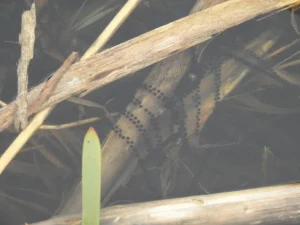
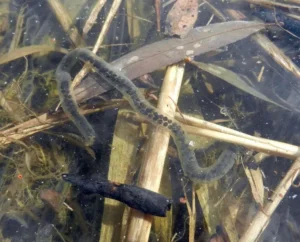
A single Common toad can lay anywhere from 1,000 to as many as 5,000 eggs each breeding season.
The eggs take about 10 to 30 days to hatch, depending on the ambient temperatures.
6. Red-spotted Toad (Anaxyrus punctatus)
Unlike most toads which lay their eggs in strands, Red-spotted toad lay their eggs singly.
The eggs are often laid on the bottom of shallow rock-lined pools, and they are sometimes found in muddy bottoms of shallow temporary ponds.
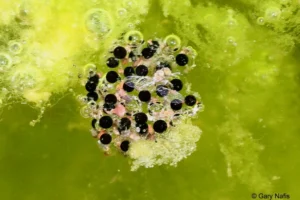
When lad, the small eggs may adhere to each other and form small clusters on the pond’s bottom.
The eggs take about 2 to 3 days to hatch, depending on the ambient temperatures.
Common Questions About Frog Eggs and Toad Eggs
What is the difference between Cane toad eggs and Frog eggs? Cane toad eggs are laid in long gelatinous strands and look almost like black beads encased in jelly. On the other hand, most frogs lay their eggs in globular clusters or masses – and never in strands.
What is the difference between Common frog eggs and Common toad eggs? Common frogs lay their eggs in large clusters, while common toads lay their eggs in parallel gelatinous strands. Common frog eggs may look almost like a cluster of grapes, while common toad eggs may look like a long jelly-covered necklace.
Sources:
The life cycle of a North American toad. Encyclopædia Britannica. https://www.britannica.com/video/22455/life-cycle-toad-North-American
Stokeo, W. J. (1980). The Observer’s Book of British Wild Animals. Frederick Warne
Stebbins, Robert C. (1951). Amphibians of western North America. University of California Press
Wright, A. 1932. Life Histories of the Frogs of Okefinokee Swamp, Georgia: North American Salientia (Anura) No. 2. United States: Cornell University Press.


